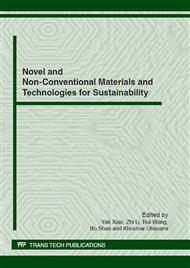[1]
World Business Council for Sustainable Development (WBCSD), The Cement Sustainability Initiative (CSI), 2007, 8p. (CSI Report). Available: <http: /wbcsd. org>.
Google Scholar
[2]
K. Humphreys, M. Mahasenan, Substudy 8: Climate Change, In: Battelle. Toward a Sustainable Cement Industry, 2002, 34p (WBCSD Report). Available: <http: /wbcsd. org>.
Google Scholar
[3]
Office For Climate Change (OCC), Stern Review: the Economics of Climate Change, 2005, 27p. (Executive Summary). Available: <http: /www. occ. gov. uk/activities/stern. htm>.
Google Scholar
[4]
L. Bernstein et al, Chapter 7: Industry, in: Metz et al (ed). Climate Change 2007: Mitigation – Contribution of Working Group III to the Fourth Assessment Report of the Intergovernmental Panel on Climate Change, Cambridge University Press, Cambridge, United Kingdom and New York, USA, 2007, pp.447-496.
DOI: 10.1080/01944363.2014.954464
Google Scholar
[5]
World Business Council For Sustainable DevelopmenT (WBCSD), Cement Technology Roadmap 2009 – Carbon Emissions Reductions up to 2050, 2009, 36p. (CSI Report). Available: <http: /wbcsd. org>.
Google Scholar
[6]
N. Müller, J. Harnish, A blueprint for a climate friendly cement industry. Gland: WWF Lafarge Conservation Partnership, 2008, 94p. (WWF-Lafarge Conservation Partnership Report).
Google Scholar
[7]
B. L. Damineli et al, Measuring the eco-efficiency of cement use, Cement and Concrete Composites 32 (2010) 555-562.
DOI: 10.1016/j.cemconcomp.2010.07.009
Google Scholar
[8]
World Business Council For Sustainable Development (WBCSD). Cement Industry Energy and CO2 Performance - Getting the Numbers Right, 2009. 44p. (CSI Report). Available: <http: /wbcsd. org>.
Google Scholar
[9]
Pira International – Intertechpira, Future of ferrous slag: market forecasts to 2020, 2009, 144p. (Market Report). Available: <http: /www. intertechpira. com/Future-of-Ferrous-Slag-Market-Forecasts-to-2020. aspx>.
Google Scholar
[10]
USGS. Iron and steel slag statistics, 2010, 3p. Available: <http: /minerals. usgs. gov/ds/2005/140/>.
Google Scholar
[11]
Instituto Brasileiro de Siderurgia (IBS), Siderurgia Brasileira: Relatório de Sustentabilidade 2008, 2008, 64p. (in portuguese) (Fourth Assessment Report). Available: <http: /www. ibs. org>.
Google Scholar
[12]
E. Gartner, Industrially interesting approaches to low CO2, cements, Cement and Concrete Research 34 (2004) 1489-1498.
DOI: 10.1016/j.cemconres.2004.01.021
Google Scholar
[13]
J. K. Yamamoto et al, Environmental Impact Reduction on the Production of Blended Portland Cement in Brazil, Environmental Geosciences 4 (1997) 192-206.
Google Scholar
[14]
United States Environmental Protection Agency (EPA), Study on Increasing the Usage of Recovered Mineral Components in Federally Funded Projects Involving Procurement of Cement or Concrete to Address the Safe, Accountable, Flexible, Efficient Transportation Equity Act: A Legacy for Users, 2008, 225p. Available: <http: /www. epa. gov/osw/conserve/tools/cpg/pdf/rtc/report4-08. pdf>.
DOI: 10.4135/9781483346526.n422
Google Scholar
[15]
American Concrete Institute (ACI), 234R-06: Guide for the Use of Silica Fume in Concrete, 2006, 63p. Available: <http: /www. concrete. org/bookstorenet/ProductDetail. aspx?ItemID=23406>.
DOI: 10.14359/978
Google Scholar
[16]
Malhotra, V. M., Availability and management of fly ash in India, The Indian Concrete Journal (2005), 5p. Available: <http: /www. icjonline. com/forum/Point_of_view. pdf>.
Google Scholar
[17]
USGS, Coal and combustion production statistics, 2010, 3p. Available: <http: /minerals. usgs. gov/ds/2005/140/>.
Google Scholar
[18]
B. R. Stewart, R. S. Kalyoncu, Materials Flow in the Production and Use of Coal Combustion Products, in: 1999 International Ash Utilization Symposium, Center For Applied Energy Research University of Kentucky, paper 46, 1999, Proceedings… Kentucky, 1999, 9p. Available: <http: /www. flyash. info/1999/econom/kalyon2. pdf>.
DOI: 10.4177/ccgp-d-15-00008.1
Google Scholar
[19]
M. Höok et al, A supply-driven forecast for the future global coal production, Contribution to ASPO, 2008, 48p. Available: <http: /www. tsl. uu. se/uhdsg/Publications/Coalarticle. pdf>.
Google Scholar
[20]
CEMBUREAU, Environmental benefits of using alternative fuels in cement production – a life-cycle approach, 1999, 25p. Available : <http: /www. cembureau. be>.
Google Scholar
[21]
J. S. Damtoft, et al, Sustainable development and climate change initiatives, Cement and Concrete Research 38 (2008) 115-127.
DOI: 10.1016/j.cemconres.2007.09.008
Google Scholar
[22]
A. Josa, et al, Comparative analysis of available life cycle inventories of cement in the EU, Cement and Concrete Research 34 (2004) 1313-1320.
DOI: 10.1016/j.cemconres.2003.12.020
Google Scholar
[23]
International Energy Agency (IEA), Energy Technology Perspectives – Scenarios & Strategies to 2050, 2006, 486p. Available : <http: /www. iea. org/Textbase/techno/etp/index. asp>.
Google Scholar
[24]
United States Geological Survey (USGS), USGS Minerals Yearbook: Cement Annual Report 2005, 2007, Available: <http: /minerals. usgs. gov/minerals/pubs/commodity/cement/cemenmyb05. pdf>.
DOI: 10.4135/9781412939591.n1177
Google Scholar
[25]
Associação Brasileira de Normas Técnicas (ABNT), NBR 12655: Concreto de cimento Portland – Preparo, controle e recebimento – Procedimento, Rio de Janeiro, 2006, 18p (in portuguese).
Google Scholar
[26]
H. Grube, B. Kerkhoff, The new German concrete standerds DIN EN 206-1 and DIN EN 1045-2 as basis for the design of durable constructions, Concrete Technology Reports (2004) 19-27.
Google Scholar
[27]
R. Wassermann, A. Katz, A. Bentur, Minimum cement content requirements: a must or a myth?, Materials and Structures 42 (2009) 973-982.
DOI: 10.1617/s11527-008-9436-0
Google Scholar
[28]
P. K. Mehta, Society, Sustainability and the global concrete industry, Curitiba, 08 out. 2009, Speech on 51º Brazilian Congress of Concrete (IBRACON), Curitiba, (2009).
Google Scholar


